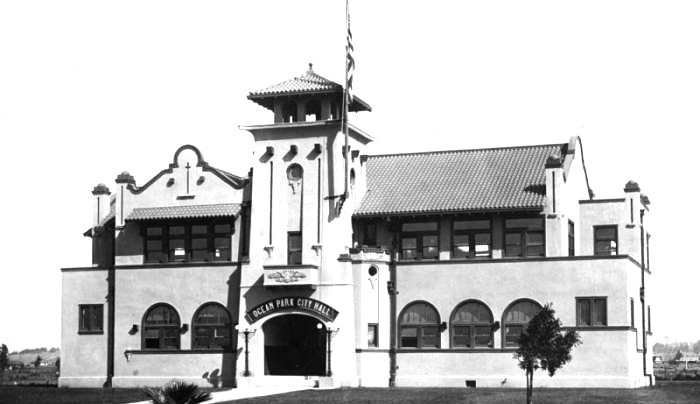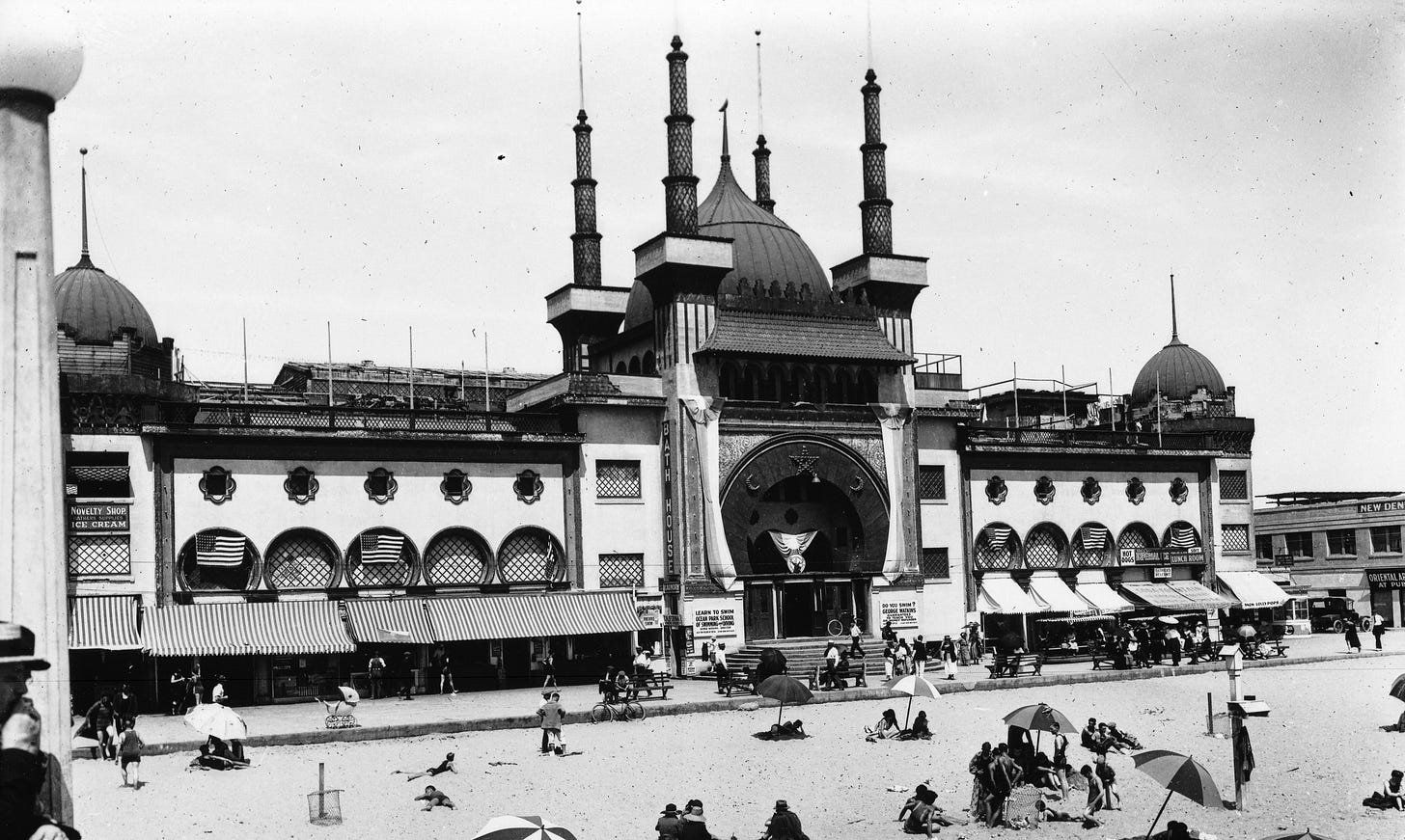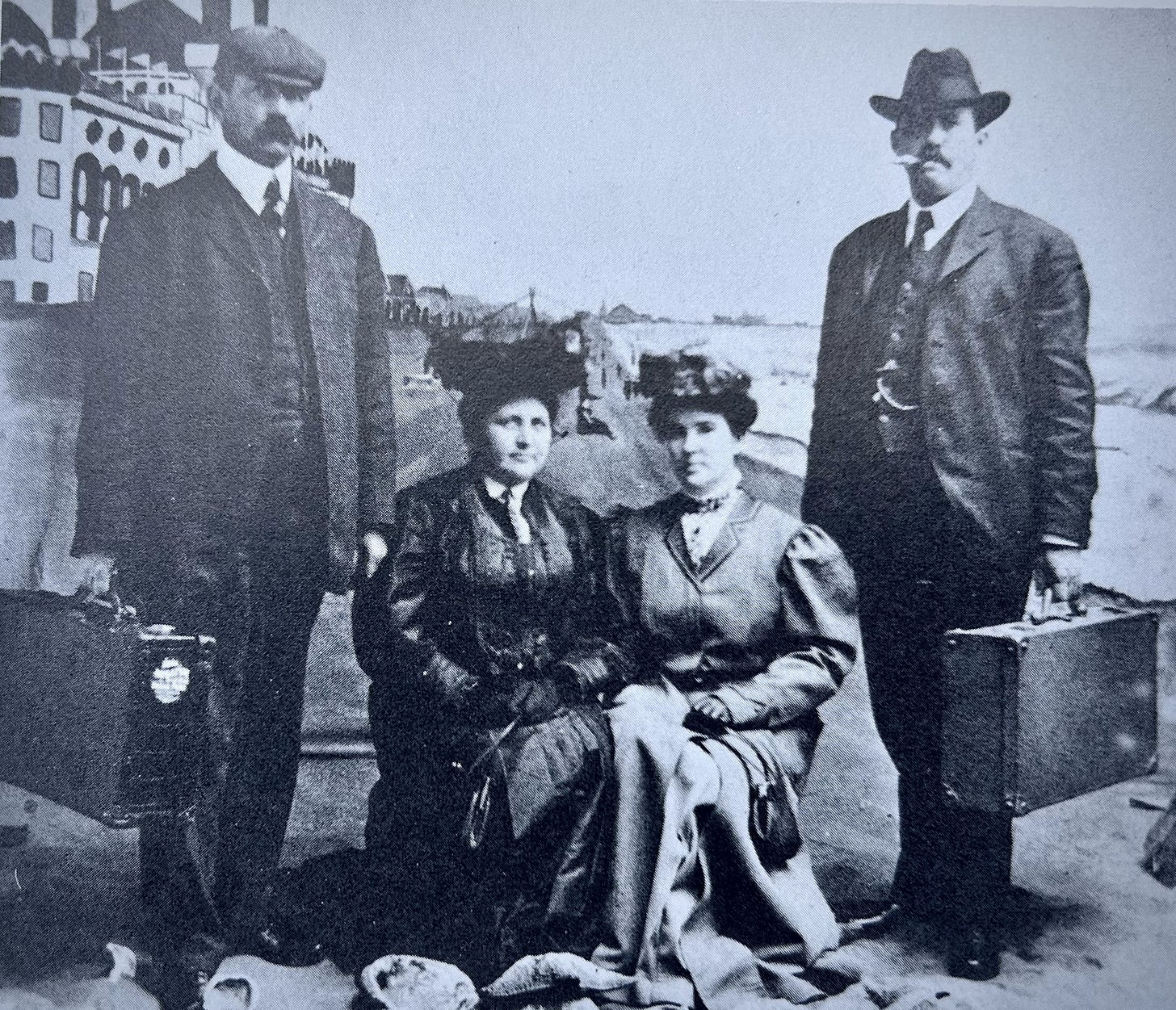
We saw how Ocean Park (Santa Monica) came into existence - let’s move on to Ocean Park (Venice). The confusion begins. The City of Ocean Park, adjacent and south of Santa Monica, existed from 1904 to 1911, when it was renamed Venice.
Francis Ryan dies in 1898. Matilda Ryan1 marries Thomas Dudley a Santa Monica businessman and politician in 1899. Kinney has a new partner. Thomas Dudley finds it difficult working with Kinney2 and in 1902 sells the Dudleys’ half interest in the partnership for $400,000 to Alexander Fraser, H.R. Gage,3 and George Merritt Jones.4
In 1903 Kinney and Fraser, Gage, and Merritt Jones organize (but do not incorporate) the “Ocean Park Improvement Company.” They install a sewer system, extend the beach walkway, and develop the residential tract immediately south of Navy. Always the dreamer, Kinney has bigger plans. His immediate plans are: (i) get rid of his partners, and (ii) create an independent municipality that he can control.5
In 1904 Kinney and his partners (Fraser, Gage, and Merritt Jones) meet to dissolve their Ocean Park Improvement Company partnership by the division of their property.6 Kinney acquires title to the undeveloped marshy southern part of the property and forms the “Abbot Kinney Company” to build his Venice of America.
Kinney's former partners (Fraser, Gage, and Merritt Jones) improve their north half around the pier with a $185,000 Ocean Park Bathhouse - an indoor hot saltwater swimming pool. It opens the same weekend that Kinney's Venice of America opens - July 4, 1905.
In 1904 the voters in unincorporated Los Angeles County south of Santa Monica vote to form the City of Ocean Park.7 The post office of “Ocean Park, CA” (which Kinney was instrumental in obtaining) remains within Santa Monica. As two post offices in a state cannot have the same name, the City of Ocean Park’s post office is named Venice, CA. The Santa Monica / City of Ocean Park boundary cuts through properties on Marine - causing disputes about which city has jurisdiction.8
By 1907, the City of Ocean Park is dysfunctional as the Board of Trustees fight with Kinney. A disincorporation movement forms and in 1908 Kinney’s slate gains control of the Board of Trustees. In 1909, there is an attempt to “consolidate” Santa Monica and the City of Ocean Park. Santa Monica votes in favor but the City of Ocean Park votes against and the proposal dies.9
In 1911, by an almost unanimous vote of City of Ocean Park residents seeking to end the confusion, the city is renamed the City of Venice.10
Venice exists as an incorporated city until it is annexed by the City of Los Angeles in 1925.11
Matilda Brooks Ryan Dudley (1860 – 1940)
Matilda is born in San Francisco, the daughter of California pioneer Francis Wycoff Brooks (1821–1885) and Matilda Cushman Smith (1831–1897). In 1868 the wealthy Brooks family moves to Vermont. In 1885 Matilda marries English immigrant Francis George Ryan (1855 – 1898). In 1888 they buy a large orange orchard in Anaheim. In 1891 they move to Santa Monica to a house on 4th St between California & Wilshire. The two children Alice Brooks Ryan (1890–1976) and Elizabeth Montague Ryan (1892– 1979) are accomplished tennis players. Matilda divorces Ryan in 1895 but they re-marry in 1897. After Ryan’s death, Matilda marries English immigrant Thomas Horace Dudley (1868 – 1934) in 1899. Matilda dies in England (visiting her daughter) during WWII.
Santa Monica's business establishment quickly realizes that Kinney's resort will draw tourist dollars from the north beach. Despite political connections, municipal assistance for Kinney's resort produced few results, and city services were lacking. Santa Monica's businesses are unwilling to support Kinney's plan to compete against Sherman and Clark's Los Angeles-Pacific (LA-P) trolley service. While Kinney is wealthy enough to take on rival businessmen, Dudley prefers to work with them.
Herbert Richmond Gage (1848 – 1930)
H.R. Gage is the quiet person of the Ocean Park Improvement Company (and is often confused with former California governor Henry T. Gage (1852 - 1924).) Born in New Hampshire, Gage is involved in silver mining in Tombstone, AZ (probably with E.B. Gage, superintendent of the Grand Central mine). In 1888, H.R. Gage marries Mary Alice Stickney Gage (1845 – 1903) - the widow of Clarence Newton Gage (1845 – 1876), who is the brother of E.B. Gage. Herbert and Mary Alice’s son Walter Taylor Gage (1892 – 1965) is born in Tombstone. The Tombstone silver mines run out, and in 1894, all the Gages move to the Congress gold mine near Prescott, AZ. H.R. Gage comes to Santa Monica in 1899, and in 1902 associates with A. R. Fraser and G. Merritt Jones. The three purchase Matilda Dudley’s one-half interest in the Kinney & Dudley partnership. Gage builds a $4,000 house at Dudley and Ocean Front. After Mary Alice Gage dies in 1903, Gage soon marries Irma Gage (1866 – 1922). In 1906 Gage and Fraser form the Comprehensive Company to invest in land and water in Topanga, and in 1909 Gage builds a house (Sycamore Lodge) in Topanga (Calabasas). In 1913 Gage buys a house at St Andrew’s Place and Pico in Los Angeles for $26,000. In 1928 Gage (age 79) marries Margaret Lucille Mears (1870 – 1933+). He is living at 1143 Lincoln Blvd when he dies.
George Merritt Jones (1861 – 1932). Born in Kentucky, Merritt Jones attends school in Illinois. In 1882, he enters the grain and livestock business. In 1885, he operates a general merchandise store in Montana. In 1895, Merritt Jones moves to Los Angeles and works for the City of Los Angeles (streets department) and moonlights in real estate. In 1902, he associates with A. R. Fraser and H. R. Gage, and they purchase Matilda Dudley’s half interest in the Kinney & Dudley partnership. In 1903, Kinney and Fraser, Gage, and Merritt Jones organize (but do not incorporate) the “Ocean Park Improvement Company.” The firm builds the Ocean Park Casino (restaurant and vaudeville theater), the Ocean Park Bath House, the Ocean Park Auditorium, and the Ocean Park Masonic Temple. Also 80 acres even further to the south were bought from Recreation Gun Club, subdivided, and sold. In 1904, Merritt Jones is elected to the first Board of Trustees of the City of Ocean Park. He is president of the City Water Company. Merritt Jones marries Olive Byrne (1872–1956) in 1902. In 1907, he purchases land in Imperial Valley. Merritt Jones loses heavily (Marine Apartments, Ocean Park Casino, and Bowling Alley) in the 1912 Ocean Park fire. In 1912, he sells his Imperial Valley ranch, and builds a large reinforced concrete, “fire-proof” hotel on Marine St. In 1914, Merritt Jones buys a house in Berkeley Square in Los Angeles for $37,500 - which he sells in 1920 to Hal Roache and his wife, actress Marguerite Nichols for $45,000. He moves to 2230 La Mesa Drive in Santa Monica.
Fraser and Merritt Jones’s focus is on their ventures at the pier. They disagree with Kinney on how the wetlands on the southern portion of their land should be developed. They weren't willing to make enemies of powerful rival businessmen by supporting Kinney's rival trolley company.
Fraser and Merritt Jones are resentful of Kinney, taking every available opportunity to thwart their former partner’s plans. Fraser and Merritt Jones’s political forces control the City of Ocean Park from 1904 until 1908, when Kinney’s “Good Government League” slate takes over.
The oft-told story that Kinney wins a coin toss and chooses to own the marshy property at the south end is probably apocryphal.
The vote to incorporate the City of Ocean Park is 52 for, 2 against. Dana Burks, George Merritt Jones, A. E. Robinson, W.T. Gibbon, and Force Parker (1866 - 1946) are elected City of Ocean Park’s first City Trustees.
Santa Monica is a little arbitrary in establishing its corporate boundaries in 1886. The south boundary is the south border of the Lucas Ranch, but then continues westerly on the same straight line across the Kinney and Ryan tract - without taking into consideration the orientation of the Kinney and Ryan tract. In return, Kinney and Ryan ignore the boundary in subdividing their tract. So along the south side of Marine, west of Neilson, the boundary cuts through some lots i.e. some lots are partially in Santa Monica and partially in the City of Ocean Park (Venice).
Consolidation essentially means that the City of Ocean Park (pop. 3,500) is absorbed by Santa Monica (pop. 12,000). The consolidation would potentially reduce the size of the government - and would eliminate the boundary problem. The Santa Monica City Council is in favor, but the City of Ocean Park Trustees are against it. Besides the City of Ocean Park losing its independence, the old issues over sewage, and the post office arise. Santa Monica votes in favor of consolidation (617 for, 453 against) but the City of Ocean Park votes against (148 for, 252 against).
After years of often bitter dispute between north and south Santa Monica interests, in 1914 the Santa Monica post office becomes the main post office, and the postal address Ocean Park, CA no longer exists.
Kinney dies in 1920, and Venice's politics become unmanageable. Its roads, water, and sewage systems badly need repair and expansion to keep up with its growing population. Venice voters prefer to be annexed to either Santa Monica or Los Angeles. But a consensus cannot be reached - the city's scattered business interests competed against each other. Several annexation elections are held between 1923 and 1925 before the voters finally decide in 1925 to become part of the City of Los Angeles.
Los Angeles Sunday Blue Laws immediately become effective – Sunday dancing and gambling games are banned. Business suffers on the Venice Pier and Lick Piers as Sunday customers go to the Ocean Park Pier in nearby Santa Monica. The City of Los Angeles has little interest in Venice. By 1929, all of the original canals built by Kinney are filled in and replaced by roads.







